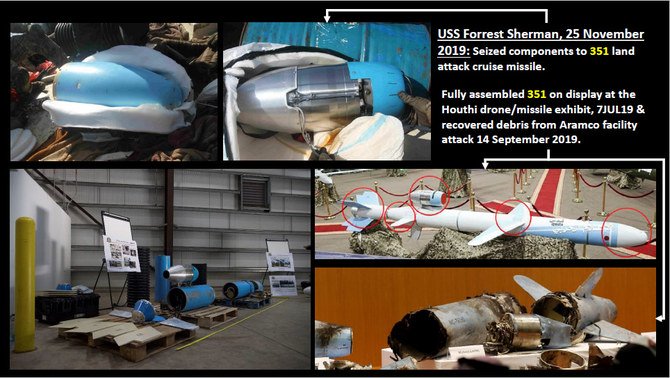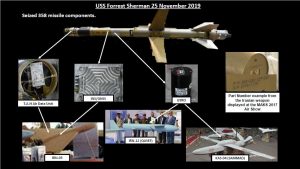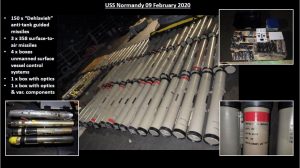
- ARAB NEWS
- 18 Apr 2024

Jonathan Lessware, London
Iranian cruise missile parts seized from a boat in the Arabian Sea matched those used in the attack on Saudi Aramco facilities, US military officials said.
The equipment was part of a shipment of sophisticated weaponry seized from a dhow in November destined for Houthi militants in Yemen. Another dhow carrying similar weapons was raided by the US Navy this month.
During a briefing Wednesday, Capt. Bill Urban of US Central Command, which is responsible for US forces in the Middle East, detailed the various missiles and other materiel discovered on the two boats.
[caption id="attachment_11228" align="alignnone" width="300"] One of the five, near-fully assembled Iranian-made "358" surface-to-air missiles. (US Central Command)[/caption]
One of the five, near-fully assembled Iranian-made "358" surface-to-air missiles. (US Central Command)[/caption]The findings are the latest in an extensive body of evidence showing Iran supplying the Houthis with increasingly sophisticated weapons in breach of a UN arms embargo. They also show the extent to which Iranian weapons are being used to attack Saudi Arabia and other countries across the region.
Among the weapons found on board the dhow in November were anti-tank missiles, advanced “358” surface-to-air missiles and components used for land and sea cruise missiles, and drones, Urban said.
“This includes components of a ‘351’ land-attack cruise missile that matches the missiles used by Iran to attack the Aramco refineries in the Kingdom of Saudi Arabia last September,” he added.
https://youtu.be/dKBvDVh-TXA
The US believes the attacks on the Abqaiq processing plant and Khurais oil field were launched from Iran rather than Yemen, contrary to a claim from the Houthis that they had mounted the attack.
The UN and Saudi Arabia have also dismissed that the drone and cruise missile raid came from Yemen in the south and instead hit the targets in the Kingdom from the north.
The attacks, which Iran denied carrying out, temporarily cut off more than five percent of global oil supplies.
[caption id="attachment_11229" align="alignnone" width="300"] Weapons seized by the USS Normandy in February included anti-tank weapons, surface-to-air missiles, and various electronic components for unmanned systems. (US Central Command)[/caption]
Weapons seized by the USS Normandy in February included anti-tank weapons, surface-to-air missiles, and various electronic components for unmanned systems. (US Central Command)[/caption]The surface-to-air missiles seized in the November raid carried out by the USS Forrest Sherman also included links to the Aramco attacks. The weapons contained high-tech components that matched those in the drones used to attack the facilities.
The independent Conflict Armament Research made similar findings in a report published Wednesday that linked the drones used in the Aramco attack to Houthi drones in Yemen and Iranian drones recovered in Iraq and Afghanistan.
Urban said the second dhow intercepted on Feb. 9 by the USS Normandy found 150 “Dhelavieh,” anti-tank guided missiles that are Iranian copies of the Russian Kornet. They also found three more of the “358” surface-to-air missiles, he said.
A US military official told the New York Times that the new weapon is designed to avoid US defensive systems and can shoot down military helicopters.
Iran has been smuggling weapons to the Houthis for at least five years since the Arab coalition, which includes Saudi Arabia, launched an operation to support Yemen’s internationally recognized government after the militia seized the capital Sanaa.
The increasing sophistication of the weapons will add to concerns that Iran is stoking the conflict as the UN attempts to broker a political solution.
“There is no doubt as to where these weapons came from or where they were going,” Urban said. “For the international community, the supply of Iranian weapons to the Houthis has often led to spillage of the Yemeni conflict beyond its borders.
“For the people of Yemen, the continual supply of Iranian weapons to the Houthis has certainly prolonged the conflict, delayed a political solution and increased the suffering of the Yemeni people.”